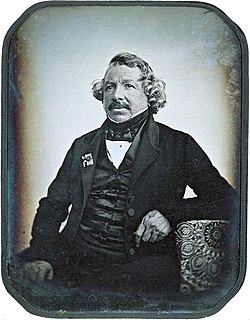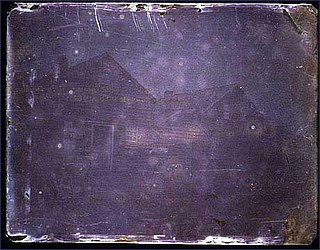
Photography is the art, application, and practice of creating durable images by recording light, either electronically by means of an image sensor, or chemically by means of a light-sensitive material such as photographic film. It is employed in many fields of science, manufacturing, and business, as well as its more direct uses for art, film and video production, recreational purposes, hobby, and mass communication.

A photograph is an image created by light falling on a photosensitive surface, usually photographic film or an electronic image sensor, such as a CCD or a CMOS chip. Most photographs are now created using a smartphone/camera, which uses a lens to focus the scene's visible wavelengths of light into a reproduction of what the human eye would see. The process and practice of creating such images is called photography.
The following list comprises significant milestones in the development of photography technology.

Charles Cros or Émile-Hortensius-Charles Cros was a French poet and inventor. He was born in Fabrezan, Aude.

Daguerreotype was the first publicly available photographic process; it was widely used during the 1840s and 1850s. "Daguerreotype" also refers to an image created through this process.

The Autochrome Lumière was an early color photography process patented in 1903 by the Lumière brothers in France and first marketed in 1907. Autochrome was an additive color "mosaic screen plate" process. It was the principal color photography process in use before the advent of subtractive color film in the mid-1930s.

Alexandre-Edmond Becquerel, known as Edmond Becquerel, was a French physicist who studied the solar spectrum, magnetism, electricity and optics. He is credited with the discovery of the photovoltaic effect, the operating principle of the solar cell, in 1839. He is also known for his work in luminescence and phosphorescence. He was the son of Antoine César Becquerel and the father of Henri Becquerel, one of the discoverers of radioactivity.

Sergey Mikhaylovich Prokudin-Gorsky was a chemist and photographer of the Russian Empire. He is best known for his pioneering work in colour photography and his effort to document early 20th-century Russia.
Color photography is photography that uses media capable of capturing and reproducing colors. By contrast, black-and-white or gray-monochrome photography records only a single channel of luminance (brightness) and uses media capable only of showing shades of gray.

The commune of Agen is the prefecture of the Lot-et-Garonne department in Nouvelle-Aquitaine, southwestern France. It lies on the river Garonne 135 kilometres southeast of Bordeaux.

A carbon print is a photographic print with an image consisting of pigmented gelatin, rather than of silver or other metallic particles suspended in a uniform layer of gelatin, as in typical black-and-white prints, or of chromogenic dyes, as in typical photographic color prints.

Louis Arthur Ducos du Hauron was a French pioneer of color photography.

Jonas Ferdinand Gabriel Lippmann was a Franco-Luxembourgish physicist and inventor, and Nobel laureate in physics for his method of reproducing colours photographically based on the phenomenon of interference. His parents were French Jews.

The history of photography began in remote antiquity with the discovery of two critical principles: camera obscura image projection and the observation that some substances are visibly altered by exposure to light. There are no artifacts or descriptions that indicate any attempt to capture images with light sensitive materials prior to the 18th century.

Hand-colouring refers to any method of manually adding colour to a monochrome photograph, generally either to heighten the realism of the image or for artistic purposes. Hand-colouring is also known as hand painting or overpainting.
The Joly colour process is an early additive colour photography process devised by Dublin physicist John Joly in 1894.
Utocolor or Uto paper was a light-sensitive paper for color photography manufactured by Dr. J.H. Smith of Zurich, Switzerland and available by early 1907.

Dufaycolor is an early British additive colour photographic film process, introduced for motion picture use in 1932 and for still photography in 1935. It was derived from Louis Dufay's Dioptichrome plates, a glass-based product for colour still photography, introduced in France in 1909. Both Dioptichrome and Dufaycolor worked on the same principles as the Autochrome process, but achieved their results using a layer of tiny colour filter elements arrayed in a regular geometric pattern, unlike Autochrome's random array of coloured starch grains. The manufacture of Dufaycolor film ended in the late 1950s.

Levi Hill was an American minister in upstate New York who claimed in 1851 that he had invented a color photographic process. Borrowing terms previously introduced in France, Hill called his process "heliochromy" and the photographs that it produced "heliochromes", but by analogy to the naming of the then-current daguerreotype process after its inventor Louis Daguerre, Hill's color photographs were soon being called "Hillotypes". Hill's work was met with skepticism during his lifetime, then for more than a hundred years after his death histories of photography routinely dismissed it as a complete fraud. Later researchers found that his very difficult process did in fact have a limited ability to reproduce the colors of nature.

Barrier-grid animation or picket-fence animation is an animation effect created by moving a striped transparent overlay across an interlaced image. The barrier-grid technique originated in the late 1890s, overlapping with the development of parallax stereography (Relièphographie) for 3D autostereograms. The technique has also been used for color-changing pictures, but to a much lesser extent.
















